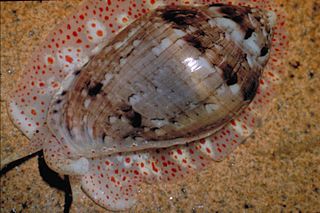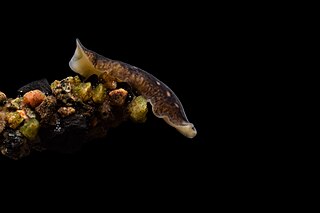
The Cottidae are a family of fish in the superfamily Cottoidea, the sculpins. It is the largest sculpin family, with about 275 species in 70 genera. They are referred to simply as cottids to avoid confusion with sculpins of other families.

Planaria is a genus of planarians in the family Planariidae. When an individual is cut into pieces, each piece has the ability to regenerate into a fully formed individual.
Tetracapsuloides bryosalmonae is a myxozoan parasite of salmonid fish. It is the only species currently recognized in the monotypic genus Tetracapsuloides. It is the cause of proliferative kidney disease (PKD), one of the most serious parasitic diseases of salmonid populations in Europe and North America that can result in losses of up to 90% in infected populations.

Cardinalfishes are a family, Apogonidae, of ray-finned fishes found in the Atlantic, Indian, and Pacific Oceans; they are chiefly marine, but some species are found in brackish water and a few are found in fresh water. A handful of species are kept in the aquarium and are popular as small, peaceful, and colourful fish. The family includes about 370 species.

The king quail, also known as the blue-breasted quail, Asian blue quail, Chinese painted quail, or Chung-Chi, is a species of Old World quail in the family Phasianidae. This species is the smallest "true quail", ranging in the wild from southern China, South and Southeast Asia to Oceania, south to southeastern Australia, with 9 different subspecies. A failed attempt was made to introduce this species to New Zealand by the Otago Acclimatisation Society in the late 1890s. It is quite common in aviculture worldwide, where it is sometimes misleadingly known as the "button quail", which is the name of an only very distantly related family of birds, the buttonquails.

Comephorus, known as the golomyankas or Baikal oilfish, are a genus comprising two species of peculiar, sculpin fishes endemic to Lake Baikal in Russia. Comephorus is the only genus in the subfamily Comephorinae. Golomyankas are pelagic fishes and the main food source for the Baikal seal.

The minute black scavenger flies or "dung midges", are a family, Scatopsidae, of nematoceran flies. Despite being distributed throughout the world, they form a small family with only around 250 described species in 27 genera, although many await description and doubtless even more await discovery. These are generally small, sometimes minute, dark flies, generally similar to black flies (Simuliidae), but usually lacking the humped thorax characteristic of that family.

Marginella is a very large genus of small tropical and temperate sea snails, marine gastropod molluscs in the subfamily Marginellinae of the family Marginellidae, the margin snails. It is a type of genus family.

The ruby-cheeked sunbird is a species of sunbird in the family Nectariniidae.
Ctenoplana is a genus of comb jellies, and the only genus in the family Ctenoplanidae. It comprises the following species:

Dendrocoelidae is a family of freshwater tricladida flatworms that has a holarctic distribution.

Doliolidae is a family of tunicates in the order Doliolida. Members of the family are pelagic and often found far away from coastlines.

Eumicrotremus is a genus of lumpfishes native to the northern oceans. The name for this genus comes from the Greek roots eu meaning "good", mikros meaning "small" or "little", and trema meaning "hole".
Dolioletta mirabilis is a species of tunicate in the family Doliolidae. It is small, exists in various forms and is sometimes found in great abundance in the Indo-Pacific waters where it lives.
Paraperipatus is a genus of velvet worms in the family Peripatopsidae. The number of legs vary within species as well as among species in this genus and can range from as few as 21 pairs up to 27 pairs in males and 29 pairs in females. The maximum number of leg pairs recorded in this genus (29) is also the maximum number of leg pairs found in the family Peripatopsidae. This genus exhibits matrotrophic viviparity, that is, mothers in this genus retain eggs in their uteri and supply nourishment to their embryos, but without any placenta. Species in this genus are found in New Guinea and Maluku, Indonesia.

Baikalobia is a genus of freshwater triclad in the family Dendrocoelidae. Species have been documented in Russia.

Papilloplana is a genus of triclads belonging to the family Dendrocoelidae.
Bdellocephala melanocinerea is a species of freshwater triclad in the family Dendrocoelidae.
Ralpharia is a genus of hydrozoans belonging to the family Tubulariidae.

Baikalobia variegata is a species of freshwater triclad in the family Dendrocoelidae. It has been found in Lake Baikal.














